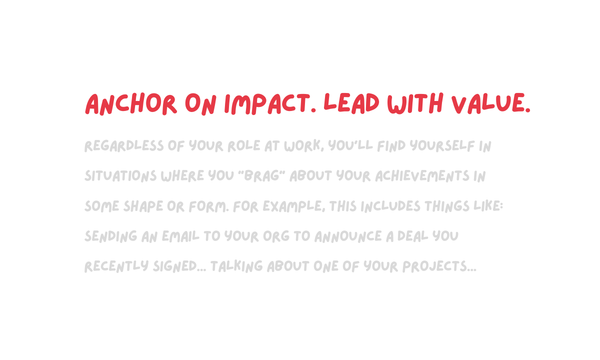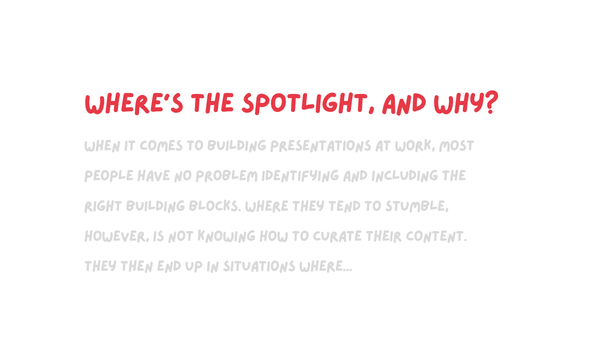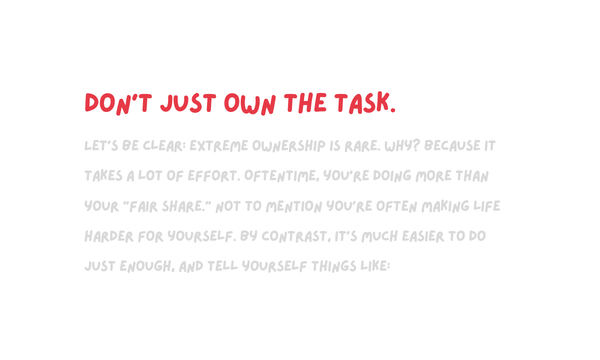A "simple update" is never that simple

Regardless of where you are in your career – you will find yourself in situations where someone is asking you for a "quick update" on something.
For example:
- Your manager: "I'm meeting our big boss next week and want to make sure he's aware of the progress on Project X. Can you drop me a couple bullet points?"
- Your stakeholder: "I'd like to give our product teams a sense of the challenges we face in this market – can you give me a couple talking points on the unique user behaviors we see?"
- Your teammate: "I'm doing a business review on behalf of our team, and I want to call out some recent wins. Can you give me a short summary on our recent partnership with Partner X?"
The mistake that most people make?
When an ask like this reaches their desk, they treat it as a trivial task. After all, the stakes seem low. Not to mention that someone else is the owner.
As a result? Most people put little thought into these tasks. They simply write down whatever is top of mind, ship it off, and think their job is done.
What they don't realize is this:
- These things matter. Your influence and visibility will only grow if other people are able to represent you well. And that starts with the basic hygiene of writing sharp updates.
- When you do a shoddy job? You're only hurting yourself. If people cannot decipher what you write – they will either underrepresent or even misrepresent your work. This hurts you, not them.
- It's harder than you think. Given the constraints of real estate, it takes incredible finesse to say just enough, but not too much. And most people underestimate how hard this is.
So in today's newsletter: we'll look at some common mistakes to avoid – as well as what it actually takes to write a proper "simple update."
👋 Join 5000+ readers and subscribe to Herng's Newsletter for free:
#1 Most people tell the wrong story.
Let's imagine that you just negotiated a complex deal with a partner after multiple quarters of engagement.
Your manager then asks you for a couple bullet points so she can include it in an org-wide newsletter.
The mistake that a lot of people make? They'll write bullet points like:
- Signed deal with Partner X after multiple quarters of engagement; public announcement to happen in 3 weeks
- Deal started out as an experiment, and evolved into a formal partnership over time
- Deal will be governed by our finance team, in order to track ongoing impact and assess whether we exercise our opt-out clause.
The issue with writing an update this way? You're telling the wrong story. Because consider the following:
- ❌ "Public announcement to happen in 3 weeks" — This might matter for someone who's involved in the deal and cares about upcoming timelines. But for everybody else? It's just an operational detail. It's not very useful.
- ❌ "Deal started out as an experiment..." – Again, why should anyone else care about the origin story? Does it have implications for future opportunities? If so, why aren't you talking about it? If not – it's just a random fact – and a waste of space.
- ❌ "Deal will be governed..." – Why does it matter who tracks impact? Also, hold on: we negotiated an opt-out clause? That seems to be the most unique part of this deal – why is it being treated like an afterthought?
By contrast, take a look at what a well-crafted update chooses to focus on:
- ✅ Focused on impact: "Signed deal with Partner X after multiple quarters of engagement; deal is expected to bring x% growth in user engagement this year, directly contributing to our org-level OKRs"
- ✅ Focused on future implications: "Signed deal with Partner X... which is the first time we've been able to incorporate an opt-out clause (by offering early access to Y in return). Deal paves way for signing similar deals with other partners in market."
- ✅ Focused on value for others: "Signed deal with Partner X... and developed a customizable playbook that can be immediately scaled across other markets to help grow user adoption."
If you look closely enough? You'll notice that well-crafted updates all have one thing in common.
And it's that they try to talk about stuff that their audience actually cares about. Stuff that brings some sort of value to the audience.
Sometimes it's about business impact. Sometimes it's about insights for the business. Sometimes it's about how it can help others.
But whatever it is – it's not about you. It's about your audience.
⭐ Want access to my favorite slide templates, cheat sheets, and storytelling tricks? It's all here — and it's 100% free.
#2 Remember: this isn't poetry class.
Writing the "right" story is only the first step. You also have to write in a way that is decipherable.
Because another common mistake people make?
It's to assume that because they're writing in a bullet point format, they're allowed to optimize for brevity with abandon. This then leads them to pen incomplete thoughts using dangling phrases.
(This is almost always a reflection of lazy thinking.)
What does this mean exactly? Consider again our earlier example, where we signed a key deal after mutliple quarters of engagement.
Here are a few examples of "incomplete thoughts:"
- ❌ "Deal signed after multiple quarters of engagement (monetisation goal)"
- ❌ "Marketing campaign as unlock for phase 2's scaling plan"
- ❌ "Revenue-share agreement with partner in final stages; to focus given first-of-kind deal"
Why is this "lazy thinking?" Because consider the following:
- "...(monetisation goal)" – Do you mean that this deal will contribute to some team's monetisation goal? Which team? By how much? You create confusion rather than confidence when you drop in incomplete thoughts like this.
- "Marketing campaign as unlock..." – Do you mean that this campaign is already planned, and that it is a big unlock? Or that you're working on securing marketing support, given it is needed to unlock phase 2? Or something else? The nuance matters.
- "...to focus given first-of-kind deal" – Who is going to "focus" here? And what are we planning to do that counts as "focusing?" Is there any part of this deal we would "not focus" on? This update says nothing of substance.
Remember – this isn't poetry class. The pursuit of brevity does not give you the license to engage in lazy thinking. Brevity beyond a certain point is more harmful than helpful.
My advice then?
Unless you know your audience extremely well: you will always benefit from forcing yourself to articulate your thoughts in a fully "grammatical" manner.
You don't have to actually spell it out verbatim in your final update, of course. But it is an easy way to prevent ourselves from accidentally getting carried away by lazy thinking.
For example, here's an unpolished update:
- ❌ "Deep-dive on user journeys and secured exec buy-in; earlier launch expected (Q3)"
What are we actually trying to say? Are we saying we presented a deep-dive on user journeys to execs? Is that the reason we secured buy-in? And is that also why an earlier launch is expected (or is that just coincidence)?
You might then realize that what you're actually trying to say is this:
- 💭 "We did a deep-dive presentation on the final user journeys with product leadership, which helped us secure approval to move onto the next phase. As a result, we are on track to launch ahead of schedule (Q3 instead of Q4)."
Great. But this is too wordy. A sharper version of this update would then look something like:
- ✅ "Presented the finalized user journey to leadership and secured approval to execute next phase; on track to launch product ahead of schedule (Q3 instead of Q4) as a result."
#3 Verbiage matters. Precision matters.
OK, let's say that (a) you're telling the right story, and that (b) you've also avoided the trap of incomplete thoughts. Is that enough?
Turns out there's a third element here to get right: which is that you need to (c) fine-tune the actual verbiage you use, in order to avoid potential misinterpretation.
Because what happens a lot is this: many people write updates using words and phrases that are imprecise. And they don't realize the ambiguity they create.
Specifically, this mistake manifests itself in the following ways:
▌Overuse of acronyms or jargon
You are allowed to use acronyms or jargon. It saves time and space (duh).
But just remember: if you want your written updates to be as impactful as possible? Make sure it's designed to travel far.
In other words: Make sure your written updates don't come off as gibberish for people outside of your immediate circle. Use simpler language when possible.
Example:
- ❌ "Presented long-term dwQPU growth strategy to senior leaders, focusing especially on estimated pTXC and rCOL uplift."
- ✅ "Presented long-term premium user engagement strategy to senior leaders, focusing especially on indirect value created via platform retention."
▌Overuse of shorthand
Even if you're not using acronyms, your updates can still come off as indecipherable – even if you use perfectly simple words.
This tends to happen when you are fully engrossed in your own world, and you end up developing "shorthand" to allude to more complex concepts.
This is perfectly fine when you're working with others in your circle. For example, you might tell your manager:
- "I'm focused on landing the indirect value piece this week – but I'll tackle the marketing alignment issue next week."
This is usually fine. Because your manager probably understands exactly what you're referring to with these "shorthand" phrases.
But for someone outside of your world? This means nothing. They kind of get it – but they really don't. And that's dangerous.
So instead, tighten up your writing by getting rid of this bad habit. That's the only way it will be decipherable by people outside of your world.
For example:
- ❌ "I'm focused on landing the indirect value piece."
- ✅ "I'm focused on completing an analysis that estimates the indirect value we get from data-sharing partnerships."
▌Overuse of generic terms
When it comes to writing updates, there are certain words & phrases that are best avoided – as they tend to be ambiguous and weak. You will end up saying a lot without saying anything meaningful.
For example:
- ❌"Worked on new feature requirements with Product"
- ❌"Continuing to discuss customer acquisition strategy"
- ❌"Portfolio segmentation exercise is in progress and on track"
Look, it's not that these activities are unimportant. And it's not that you're not allowed to talk about process either (although if possible, you should always try to anchor on outcomes).
Rather, the issue is this: these types of verbiage ("worked on," "continuing to discuss," etc.) can be applied to such a wide range of situations, that they end up providing very little specificity as to what exactly you accomplished.
People have no idea if you're describing something that took 10 minutes or 10 days or 10 weeks. And that's what we mean by "generic."
So try to be precise. And anchor on deliverables if possible – don't just talk about process and tactics.
For example:
- ✅ "Co-authored a product requirement document to solve top 3 user churn issues"
- ✅ "Aligned with marketing on customer acquisition strategy for all 5 priority markets, thus ensuring Q3 launch is on track"
- ✅ "Portfolio segmentation exercise in final stages (awaiting finance sign-off); on track to present to leadership by end of month"
👋 Subscribe for free to get Herng's newsletter directly in your inbox.
Quick recap
You will be asked for "simple" updates throughout your career. But they are never that simple.
So when you write, remember:
- Tell the right story. Focus on what others actually care about.
- Articulate complete thoughts. Don't rely on dangling phrases.
- Precision matters. Fine-tune your verbiage. Minimize ambiguity.
Other helpful materials
To uplevel your writing further and land outcomes that you want, here are some more resources you can leverage:
- How to build exec-ready presentations (50-page playbook)
- How to avoid self-sabotage from unintentional signaling
- The "Goldilocks" principle of writing strategy plans
- How to write in a "polished" manner at work
- 5 "tricks" to use for effective storytelling
👋 Join 5000+ readers and subscribe to Herng's Newsletter for free:



